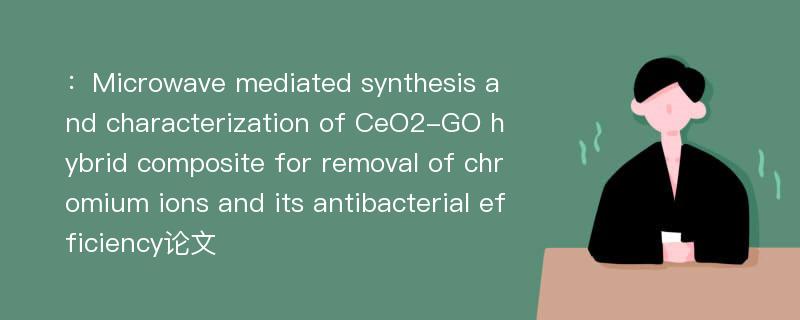
本文主要研究内容
作者(2019)在《Microwave mediated synthesis and characterization of CeO2-GO hybrid composite for removal of chromium ions and its antibacterial efficiency》一文中研究指出:A facile fabrication and processing of cerium oxide-graphene oxide(CeO2-GO) hybrid nanocomposites without the use of any surfactant or any organic solvents using chemical method and treatment with microwave irradiation technique are reported. In-situ hexagonal nano cerium oxide particles embedded on the layered surface of GO sheets were investigated for the photodegradation of dyes, removal of chromium Cr(VI) ions and against antibacterial studies. The results imply that hybrid nanocomposites shows enhanced 5-folds of photocatalytic activities in UV(ultraviolet) light irradiation and exhibited rapid efficiency in the elimination of chromium ion better than the pure GO and CeO2, which are inhibited by competent photosensitive electron inoculation and controlling the electron–hole recombination. The synergetic effect of CeO2-GO composites played a vital role in showing better results against model bacterium than GO and CeO2 are due to higher physical interaction endorsed to the stress of membranes acute by piercing edges,large surface area, and higher adsorptive conditions of graphene oxide sheets tailored with ceria particles. The amount of charge transferred at the interface increases with the concentration of O atoms, demonstrating the interaction between CeO2 and GO is much stronger than CeO2 and GO are due to the decrease of the average equilibrium distance between the interfaces. The CeO2-GO interface staggered band alignments existing between the CeO2 surfaces and GO which shows an excellent synergism. The structure and morphology of composites were tested by X-ray diffraction(XRD), Fourier transform infrared(FTIR), Raman, X-ray photoelectron spectroscopy(XPS), and high-resolution transmission electron microscope(HR-TEM).
Abstract
A facile fabrication and processing of cerium oxide-graphene oxide(CeO2-GO) hybrid nanocomposites without the use of any surfactant or any organic solvents using chemical method and treatment with microwave irradiation technique are reported. In-situ hexagonal nano cerium oxide particles embedded on the layered surface of GO sheets were investigated for the photodegradation of dyes, removal of chromium Cr(VI) ions and against antibacterial studies. The results imply that hybrid nanocomposites shows enhanced 5-folds of photocatalytic activities in UV(ultraviolet) light irradiation and exhibited rapid efficiency in the elimination of chromium ion better than the pure GO and CeO2, which are inhibited by competent photosensitive electron inoculation and controlling the electron–hole recombination. The synergetic effect of CeO2-GO composites played a vital role in showing better results against model bacterium than GO and CeO2 are due to higher physical interaction endorsed to the stress of membranes acute by piercing edges,large surface area, and higher adsorptive conditions of graphene oxide sheets tailored with ceria particles. The amount of charge transferred at the interface increases with the concentration of O atoms, demonstrating the interaction between CeO2 and GO is much stronger than CeO2 and GO are due to the decrease of the average equilibrium distance between the interfaces. The CeO2-GO interface staggered band alignments existing between the CeO2 surfaces and GO which shows an excellent synergism. The structure and morphology of composites were tested by X-ray diffraction(XRD), Fourier transform infrared(FTIR), Raman, X-ray photoelectron spectroscopy(XPS), and high-resolution transmission electron microscope(HR-TEM).
论文参考文献
论文详细介绍
论文作者分别是来自Journal of Environmental Sciences的,发表于刊物Journal of Environmental Sciences2019年02期论文,是一篇关于,Journal of Environmental Sciences2019年02期论文的文章。本文可供学术参考使用,各位学者可以免费参考阅读下载,文章观点不代表本站观点,资料来自Journal of Environmental Sciences2019年02期论文网站,若本站收录的文献无意侵犯了您的著作版权,请联系我们删除。
